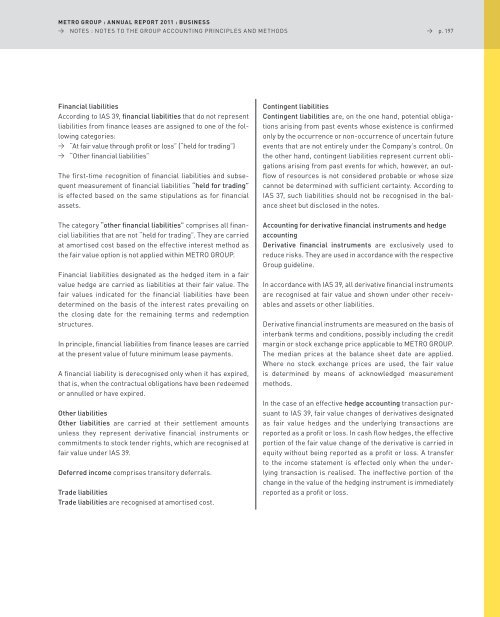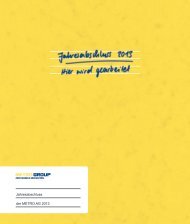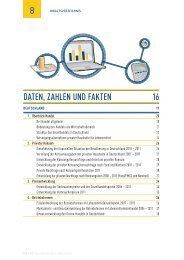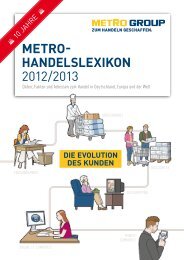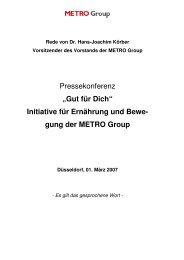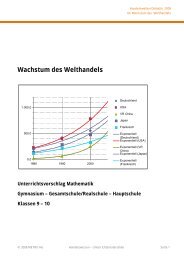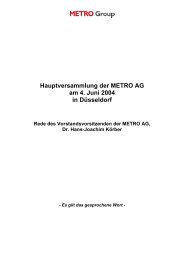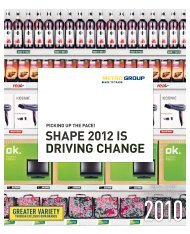pdf (22.8 MB) - METRO Group
pdf (22.8 MB) - METRO Group
pdf (22.8 MB) - METRO Group
Create successful ePaper yourself
Turn your PDF publications into a flip-book with our unique Google optimized e-Paper software.
<strong>METRO</strong> gROUP : ANNUAL REPORT 2011 : BUsiNEss<br />
→ noTes : noTes To THe GRoUp aCCoUnTInG pRInCIples anD MeTHoDs<br />
Financial liabilities<br />
according to Ias 39, financial liabilities that do not represent<br />
liabilities from finance leases are assigned to one of the following<br />
categories:<br />
→ “at fair value through profit or loss” (“held for trading”)<br />
→ “other financial liabilities”<br />
The first-time recognition of financial liabilities and subsequent<br />
measurement of financial liabilities “held for trading”<br />
is effected based on the same stipulations as for financial<br />
assets.<br />
The category “other financial liabilities” comprises all financial<br />
liabilities that are not “held for trading”. They are carried<br />
at amortised cost based on the effective interest method as<br />
the fair value option is not applied within MeTRo GRoUp.<br />
Financial liabilities designated as the hedged item in a fair<br />
value hedge are carried as liabilities at their fair value. The<br />
fair values indicated for the financial liabilities have been<br />
determined on the basis of the interest rates prevailing on<br />
the closing date for the remaining terms and redemption<br />
structures.<br />
In principle, financial liabilities from finance leases are carried<br />
at the present value of future minimum lease payments.<br />
a financial liability is derecognised only when it has expired,<br />
that is, when the contractual obligations have been redeemed<br />
or annulled or have expired.<br />
Other liabilities<br />
Other liabilities are carried at their settlement amounts<br />
unless they represent derivative financial instruments or<br />
commitments to stock tender rights, which are recognised at<br />
fair value under Ias 39.<br />
Deferred income comprises transitory deferrals.<br />
Trade liabilities<br />
Trade liabilities are recognised at amortised cost.<br />
→ p. 197<br />
Contingent liabilities<br />
Contingent liabilities are, on the one hand, potential obligations<br />
arising from past events whose existence is confirmed<br />
only by the occurrence or non-occurrence of uncertain future<br />
events that are not entirely under the Company’s control. on<br />
the other hand, contingent liabilities represent current obligations<br />
arising from past events for which, however, an outflow<br />
of resources is not considered probable or whose size<br />
cannot be determined with sufficient certainty. according to<br />
Ias 37, such liabilities should not be recognised in the balance<br />
sheet but disclosed in the notes.<br />
Accounting for derivative financial instruments and hedge<br />
accounting<br />
Derivative financial instruments are exclusively used to<br />
reduce risks. They are used in accordance with the respective<br />
<strong>Group</strong> guideline.<br />
In accordance with Ias 39, all derivative financial instruments<br />
are recognised at fair value and shown under other receivables<br />
and assets or other liabilities.<br />
Derivative financial instruments are measured on the basis of<br />
interbank terms and conditions, possibly including the credit<br />
margin or stock exchange price applicable to MeTRo GRoUp.<br />
The median prices at the balance sheet date are applied.<br />
Where no stock exchange prices are used, the fair value<br />
is determined by means of acknowledged measurement<br />
methods.<br />
In the case of an effective hedge accounting transaction pursuant<br />
to Ias 39, fair value changes of derivatives designated<br />
as fair value hedges and the underlying transactions are<br />
reported as a profit or loss. In cash flow hedges, the effective<br />
portion of the fair value change of the derivative is carried in<br />
equity without being reported as a profit or loss. a transfer<br />
to the income statement is effected only when the underlying<br />
transaction is realised. The ineffective portion of the<br />
change in the value of the hedging instrument is immediately<br />
reported as a profit or loss.


